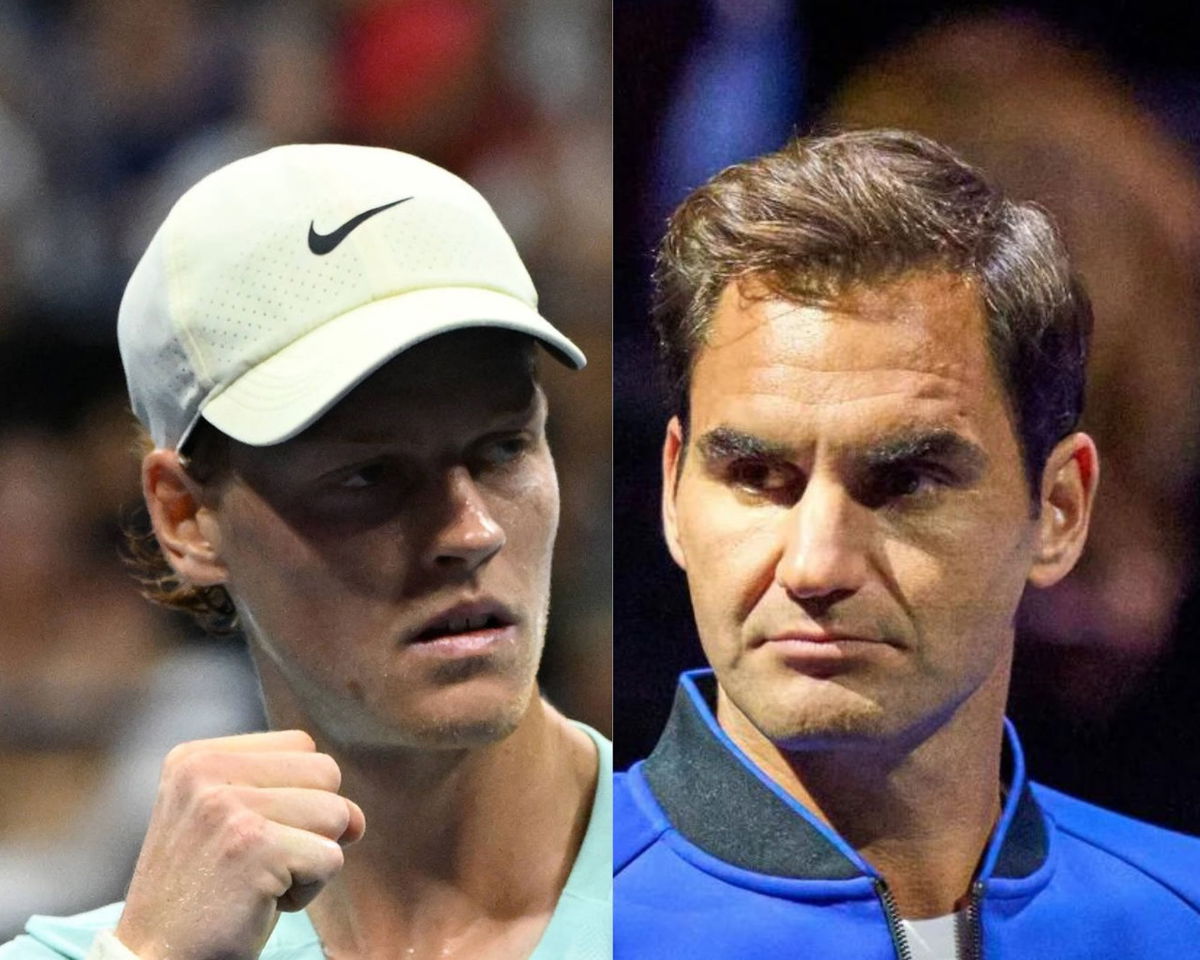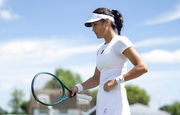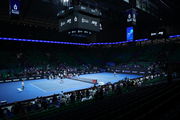
Imago
Image Credits – Imago

Imago
Image Credits – Imago
“I’m seeing you more than my family.” Carlos Alcaraz grinned after defeating Jannik Sinner in the US Open final to reclaim the World No. 1 ranking after two years. The Spaniard and the Italian have the last 8 slam finals split solely between the two. Jokes aside, maybe many of us feel the same way. For one, Roger Federer has already caught some strays as he pointed out a bigger reason why the Sincaraz is present in almost all the finals.
Watch What’s Trending Now!
The 20-time Grand Slam champion joined Andy Roddick on the Served podcast to discuss the state of the game. When asked about court speeds and if there needs to be a course correction, Federer didn’t hold back. “Yes,” Federer said emphatically. “That’s why we, the tournament directors, we need to fix it. We need to have not only fast courts, but what we would want to see is Alcaraz or Sinner figure it out on lightning fast, and then have the same match on super slow and see how that matches up.
“Sure, making the surface slower is for the weaker player. He has to hit extra amazing shots to beat Sinner. Whereas if it’s quick, he can only maybe blast a few and at the right time, and it gets passed, you know. So that’s what the tournament director is like, ‘Oh, I kind of well have Sinner and Alcaraz in the finals’, you know? It kind of works for the game. That’s the thing.”
ADVERTISEMENT
For the Swiss star, the point of the conversation comes down to how having uniform conditions across the board allows Sinner and Alcaraz to continue the same way they play. Moreover, with the two being fast already, slow courts help them get to a shot more easily. In fact, at the Laver Cup, we saw the same go down between Reilly Opelka and Casper Ruud. The latter would quickly reach the ball and return even the best serves in tennis right now at hip height. And that’s what’s happening with Sincaraz, who can process their next step much quicker.
Even outside the Slams, this duel has captivated fans. In Rome, Alcaraz defeated Sinner in a thrilling clay-court final, while at the Cincinnati Open, Sinner was forced to retire mid-match due to fitness concerns, handing Alcaraz another win. Their H2H battles have become appointment viewing, and naturally, the tennis world is buzzing about how this rivalry will shape the sport’s future. However, Federer wants to see more from the duo and the others.
In fact, these are not his thoughts alone. Former tennis professional Jimmy Connors also wants to see extra spice in the tennis world. Although he is all up for a Sinner-Alcaraz clash, Connors simply wants one more competitor to be there to add some additional heat in this fight. For this, he gave the example of how, when tennis had become all about Roger Federer and Rafael Nadal, Novak Djokovic’s entry only made the sport more fun and unpredictable. If Federer’s idea comes true, we might be able to see more competitive matches, even if it still ends up being an Alcaraz-Sinner feud.
ADVERTISEMENT
he literally singled out jannik lmao doesn't take a genius to connect 2+2 😭😭 https://t.co/Jh9dGObfmw pic.twitter.com/p4iBJrkSdv
— cherry (@kobzford) September 22, 2025
Federer went further, reminiscing about how the ATP once counted only 12 tournaments toward rankings, which encouraged players to compete on their preferred surfaces. It not only produced contrasting clashes but also forced the players to adapt.
ADVERTISEMENT
The Swiss maestro finished with a pointed observation, suggesting that tournament directors intentionally slow down surfaces to favor baseline grinders like Jannik Sinner and Alcaraz. “It’s because the tournament directors have allowed with the ball speed and the court speed that every week is basically the same… So that’s what the tournament directors are thinking, like, ‘I kind of like Sinner-Alcaraz in the finals, you know? It kind of works for the game.'”
Although Federer wants to see improvements in the sport as a whole, including the rivalry of the New Two, he is also ecstatic about them. He agrees that the Sincaraz rivalry is good for the sport, but his questioning relies on the sustainability. Still, his remarks, which some interpreted as singling out Sinner, quickly went viral, sparking accusations of bias.
ADVERTISEMENT
Fans criticize Federer’s comments on Jannik Sinner and court conditions
Sinner’s fans immediately flooded the post, turning their frustration on the Swiss icon who had casually commented on court speeds and finals matchups. The backlash was swift, sharp, and relentless, as fans dissected every word and implied intention behind Federer’s remarks. One fan summed up the sentiment perfectly: “he literally singled out Jannik lmao doesn’t take a genius to connect 2+2 😭😭.”
Another user penned a detailed critique that cut straight to the heart of the controversy: “For the illiterates who cant read subtext: Roger saying ‘so that they cant beat Sinner’ implies that he thinks ppl choosing slow courts is a way to give Sinner an advantage so that he can reach the final. It’s offensive to say such a thing because it implies that Sinner is only making these finals because of the (supposed) strategic marketing decision to use slow courts, not because he is more talented and hard working.”
Top Stories
Emma Raducanu Takes Risky New Direction to Gear Up for 2026

“Couldn’t Take It Anymore”: Ex-Grand Slam Winner Reveals Why She Decided to Quit Tennis at 26

Roger Federer Draws Criticism from Swiss Government Chief for Tourism Boom in Country

ATP’s Referees Face Stunning Change Ahead of 2026

College Tennis Star Makes Huge Leap From NCAA to Launch His Career

The fan continued, highlighting Federer’s perceived bias: “Meanwhile he doesn’t say sh*t about how this benefits Carlos, and he acts as if it is a given Carlos will reach a final under any condition. And Sinner is just the one receiving extra help (via slow courts) to get to the Sincaraz final. Aka he assumes Carlos is superior and will always reach the final ‘fairly’ with no benefit from courts, but he doesn’t think the same of Sinner. It’s offensive. He could have said ‘so that they can’t beat Carlos’ or just used both of their names, but no. He chose to single out Sinner. Roger this is so distasteful and goes against ur whole ‘I’m the classiest man in the world’ persona.”
ADVERTISEMENT
While we wouldn’t know where Federer’s loyalties lie between Alcaraz and Sinner, the public is certainly drawing an image. However, it is important to note that perhaps the former tennis superstar mentioned Sinner because he wasn’t present in the Laver Cup. Moreover, uniform courts don’t always mean predictable results, as was visible when Taylor Fritz beat Alcaraz 6-3, 6-2.
Another fan injected humor into the outrage: “This reads as if Alcaraz should go to every final in all tournaments he plays while some court modifications need to be done so other guys could beat Sinner 😹 or maybe I’m reading too much who cares.” The comment struck at the heart of the debate: whether Federer’s statement inadvertently suggested that finals appearances for Jannik Sinner were engineered, rather than earned.
To provide context, Sinner is widely regarded as one of the strongest hard-court players in the world. As the tour enters three straight months on the surface, his dominance is clear: last year, he posted a 42-3 record on hard courts, losing only twice to Alcaraz and once to Andrey Rublev. Two of those losses to Alcaraz were on slower hard courts, a minority of matches. On faster surfaces, Sinner’s sheer power and precision make him nearly unstoppable, with a serve that outperforms Alcaraz’s in consistency and effectiveness.
ADVERTISEMENT
Statistically, the margins tell the story. Sinner holds serve 91% of the time, compared to Alcaraz’s 86%, and wins 77% of points behind his first serve versus 73% for Alcaraz. These subtle but critical edges translate into dominance in the close, high-pressure matches where both men often clash.
Yet, fans continued to weigh in on Federer’s perceived oversight. Another aimed the idea of engineered advantage: “As if the best player in the world needed help to reach the final lol,” directing their vote of confidence squarely for the Italian.
Amid the chaos, another fan captured the essence of the debate: “Also like,,, he says it himself, ‘for the weaker player, he has to..’ then don’t be weak???? Why are you acting like they’re entitled to win against Sinner lmao it’s a sport.”
ADVERTISEMENT
The conversation that erupted across social media reflects the intensity of modern tennis fandom: passionate, analytical, and unafraid to challenge even the sport’s most revered figures. The discourse continues to swirl, leaving Federer’s comments dissected, debated, and immortalized in the digital arena.
ADVERTISEMENT
ADVERTISEMENT
ADVERTISEMENT

